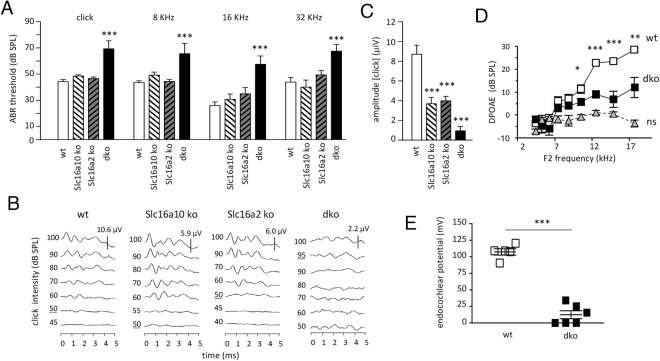Figure 1.
Auditory defects in mice lacking Slc16a2 and Slc16a10. (A) Mean thresholds for the auditory-evoked brainstem response (ABR) for click and pure tone stimuli. Groups of single and double (dko) knockout mice (n = 7 to 14) at 6–12 weeks of age. Comparison of mutants to wt used a one-way ANOVA followed by Bonferroni’s t-test; ***p < 0.0001 dko versus wt at each frequency. (B) Representative ABR waveforms for a click stimulus at different intensities showing lack of peaks in the dko. Thresholds underlined. Note different response scales (μV) for each genotype. (C) Mean amplitudes of responses to a click applied at equivalent high intensity (90 dB SPL) to each genotype. Amplitudes represent the first peak to following trough of waveforms. Groups of 3 wt and 4 to 6 mutants. Comparison of mutants to wt used a one-way ANOVA followed by Bonferroni’s t-test; ***p < 0.0001 for each genotype. (D) Distortion product otoacoustic emission (DPOAE) for adult mice. Groups of 7 mice. The dko was impaired compared to wt (Student’s t-test) for F2 frequencies above 10.5 kHz; ns, noise background. *p = 0.0299; **p = 0.0022; ***p < 0.001. (E) Endocochlear potential in 5 wt and 6 dko mice at 3 months of age. Three dko mice gave no detectable response. Student’s t-test, ***p < 0.001.

